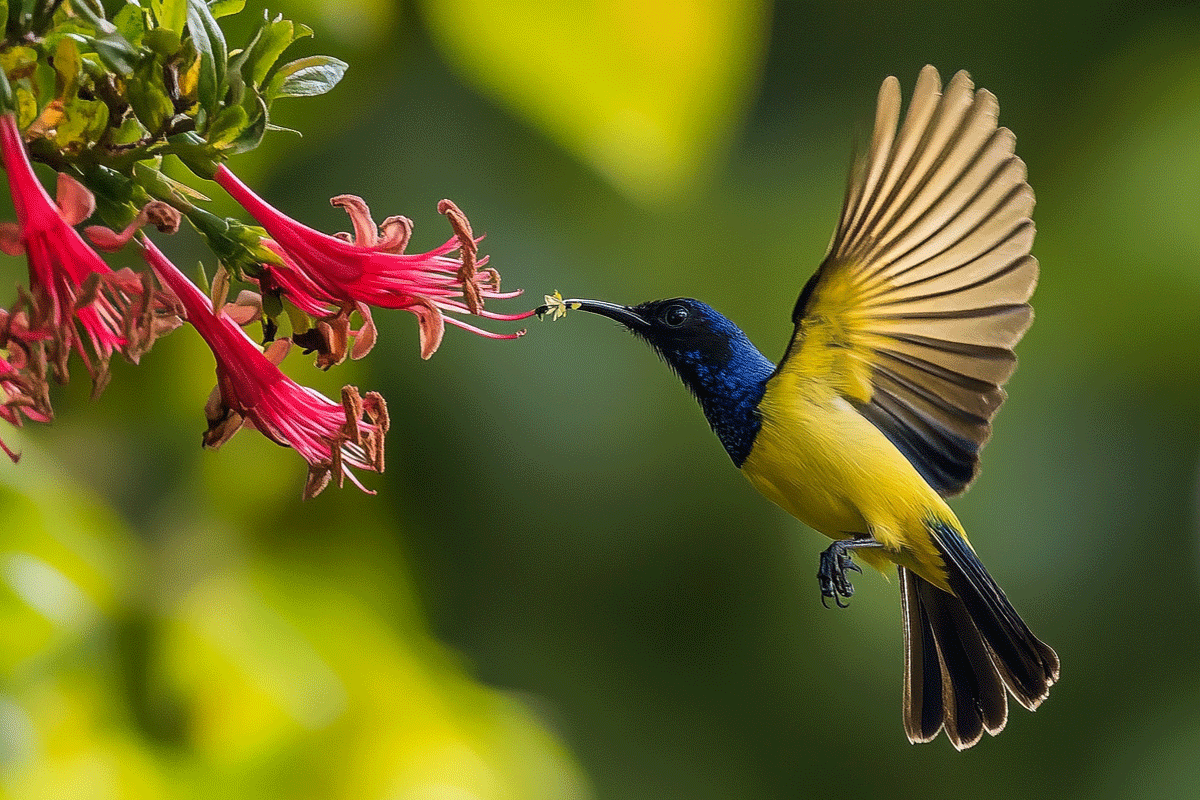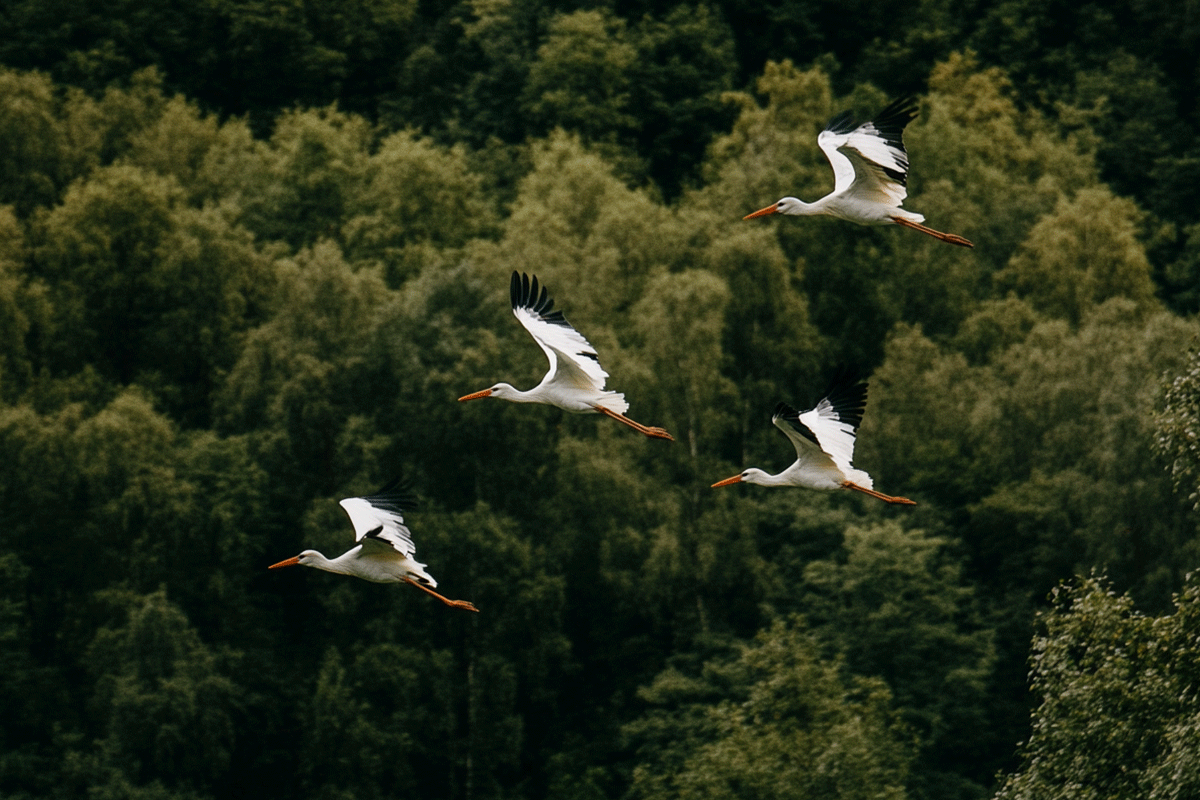Each year, millions of birds embark on one of nature’s most incredible phenomena: migration. These long-distance journeys, spanning continents and crossing oceans, are awe-inspiring, but they are also fraught with dangers. One of the most significant threats facing migratory birds is the rapid loss of their natural habitats due to deforestation and land degradation. As forests disappear, so do the critical stopover points where birds rest, feed, and refuel during their arduous journeys. This not only jeopardises bird populations but also disrupts vital ecosystems.
 A group of birds flies over the Kakamega forest, Kenya. AI generated image.
A group of birds flies over the Kakamega forest, Kenya. AI generated image.
Afforestation and reforestation (A/R), the processes of restoring forests and woodlands, are some of the most important actions we can take to reverse habitat loss and protect the future of migratory birds. And today, this work is more crucial than ever. As the world shifts toward sustainable development, reforestation is becoming a cornerstone of mitigating carbon emissions while safeguarding biodiversity.
In celebration of World Migratory Bird Day on 12 October, we delve into the critical connection between reforestation and bird migration.
The perilous journey of migratory birds puts biodiversity at risk
Migration is essential for many bird species to survive. Birds migrate to find food, escape harsh climates, and breed in optimal conditions. The journeys, which can cover thousands of miles, require birds to stop at specific resting and feeding points along the way. These stopover sites are vital for birds to regain energy, refuel, and shelter from predators or severe weather.
However, the destruction of forests worldwide has drastically reduced the availability of these critical stopover sites. The Food and Agriculture Organization (FAO) estimates that the world has lost about 420 million hectares of forest between 1990 and 2020, an area roughly half the size of Brazil. As forests disappear, migratory birds face the dual threat of losing their wintering grounds in tropical forests and their breeding habitats in temperate and boreal forests. Without these safe havens, their survival rates plummet.
Read more: 7 Strategies for protecting wildlife
The ecological importance of migratory birds
 Native to Africa, Asia, and Australia, sunbirds play a significant role in pollinating flowers as they feed on nectar. AI generated image.
Native to Africa, Asia, and Australia, sunbirds play a significant role in pollinating flowers as they feed on nectar. AI generated image.
Migratory birds are not just victims of habitat loss; they are also essential players in maintaining healthy ecosystems. Birds contribute to various ecosystem services, including:
-
Pollination: Some migratory birds, such as hummingbirds, act as pollinators, helping to maintain plant diversity.
-
Seed dispersal: Birds play a crucial role in transporting seeds across vast distances, helping to regenerate forests and promote plant colonisation in degraded areas. This natural process is also most effective in continuous forests, where habitats remain intact and interconnected. For instance, in Tanzania, seedlings of tree species dispersed by animals are three times more abundant in large forest fragments (greater than 30 hectares) compared to smaller ones (less than 9 hectares). This highlights the importance of preserving and creating large, unbroken forest areas to maintain healthy ecosystems.
-
Pest control: Many bird species help regulate insect populations, preventing outbreaks that could harm crops and forests. For instance, insectivorous birds like bluebirds, cardinals, or woodpeckers can benefit farmers by consuming important natural enemies of harvests, such as lygus bugs in strawberry fields.
When migratory bird populations decline, ecosystems lose these invaluable services, further accelerating environmental degradation. Protecting migratory birds through reforestation is not just about safeguarding the birds themselves; it’s about restoring the balance of entire ecosystems.
Read more: 10 Vital ecosystem services: sustaining life on Earth
Reforestation: a lifeline for migratory birds
 White storks return to Europe for the summer after wintering in sub-Saharan Africa, completing their epic migration journey. AI generated image
White storks return to Europe for the summer after wintering in sub-Saharan Africa, completing their epic migration journey. AI generated image
Reforestation offers a powerful solution to the challenges faced by migratory birds. By planting native trees and restoring degraded forests, we can re-establish the habitats that birds rely on during their migration. Healthy, diverse forests provide many benefits for birds at every stage of their journey:
-
Stopover sites: Reforestation can create or restore critical stopover sites where migratory birds can rest and refuel. These locations are often along major migratory routes, such as river corridors or coastal areas, where forests historically thrived.
-
Breeding grounds: Many migratory birds breed in forested areas. Restoring these habitats increases nesting opportunities and reduces the pressure on birds to find suitable breeding sites.
-
Wintering grounds: Tropical forests provide essential wintering grounds for migratory species. Deforestation in these regions forces birds into increasingly smaller and fragmented habitats, making it difficult for them to survive. Reforestation in tropical zones can reverse this trend.
Read more: Reforestation: 10 amazing benefits of planting trees
The role of DGB Group in reforestation and afforestation
DGB Group is at the forefront of global A/R efforts, with a mission to restore and expand ecosystems and protect biodiversity. By focusing on A/R as a tool for both mitigating carbon emissions and supporting nature, DGB’s projects have a unique, dual impact.
Read more: What makes DGB’s reforestation projects unique?
As we celebrate World Migratory Bird Day, let’s explore some of the key reforestation initiatives spearheaded by DGB that are making a difference for wildlife and the planet.
Our Hongera Reforestation Project aims to restore Kenya’s once-thriving forests by planting over 10 million trees across previously deforested areas. This initiative will not only capture an average of 340,000 tonnes of CO₂ per year, but also plays a vital role in nature conservation and water security by planting trees and reforesting the region. This effort leads to the restoration of biodiversity, the revitalisation of degraded lands, and the creation of essential habitats for local wildlife. Each tree planted contributes to building a robust and thriving ecosystem, promoting overall environmental health.
Read more: Every tree counts: monitoring the Hongera Reforestation Project
DGB is also leading the charge against deforestation by planting over 16 million trees in the Congo Basin region of Cameroon with the Greenzone Reforestation Project. As the largest registered carbon project in Cameroon, it not only restores vital forests but also promotes and conserves regional biodiversity, restores degraded lands, creates vital habitats for local wildlife, and plays a critical role in carbon sequestration.
Read more: New growth in Cameroon
 The osprey, a fish-eating raptor, migrates from Europe to Africa, typically to West Africa, for the winter. AI generated image.
The osprey, a fish-eating raptor, migrates from Europe to Africa, typically to West Africa, for the winter. AI generated image.
Our Bulindi Chimpanzee Habitat Restoration Project in western Uganda aims to protect the shrinking habitat of over 300 wild chimpanzees in the Hoima and Masindi districts. This afforestation and reforestation initiative focuses on restoring forested areas to safeguard these endangered primates and enhance local biodiversity. The project also supports local communities by creating sustainable livelihoods and promoting environmental education. This integrated approach ensures that conservation efforts benefit both the chimpanzees and the village households, fostering a harmonious coexistence between wildlife and people.
Read more: Nurturing harmony in Uganda—A Planet Earth III tale of the Bulindi Chimpanzee Project
Our Lake Aral Afforestation Project in Kazakhstan's Kyzylorda Region aims to restore the dried banks of the Aral Sea by planting saxaul, a resilient, salt-tolerant tree species. These trees help stabilise soil, improve air quality, and reduce the impact of sand-salt storms in the area. The project also incorporates sustainable grazing techniques to protect and enhance the restored ecosystems. This initiative is essential for rehabilitating the region and addressing the environmental challenges caused by the Aral Sea's shrinkage, contributing to long-term ecological health.
Read more: From dust to lush: the revitalisation of Lake Aral's banks
Let’s create a positive impact on nature, together
On 12 October, we celebrate World Migratory Bird Day, and we invite you to make a significant impact on the lives of these birds and the health of our planet by joining our Green Earth Tree Planting Subscription. Your participation will directly support crucial A/R efforts that restore the vital habitats migratory birds and other animals depend on during their journeys.
Our mission is both ambitious and vital: to plant millions of trees, restore forests, and enhance natural ecosystems, including those crucial for migratory birds. Through our global reforestation projects, we are planting over 31 million trees, and you can be a part of this important work!
By subscribing, you choose the number of trees to plant in just a few simple steps, and we take care of the rest—from growing the seedlings to planting them and providing you with regular updates on your growing forest. Each tree you plant can absorb the same amount of CO2 as 2,500 kilometres driven by a gasoline car or 60,000 smartphone charges over its lifetime.
Joining the Green Earth initiative means more than just planting trees—you’re contributing to the preservation of biodiversity and creating safe habitats for migratory birds and other animals. Together, we can create a greener future for all. Ready to make a meaningful impact?







